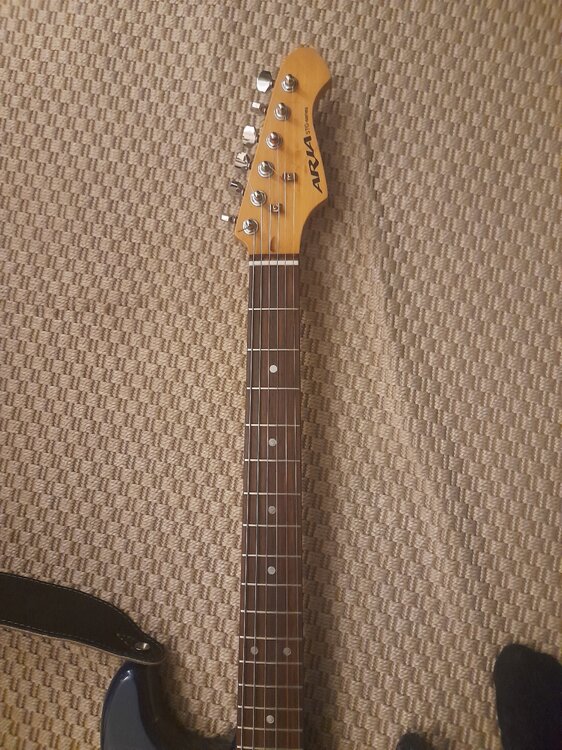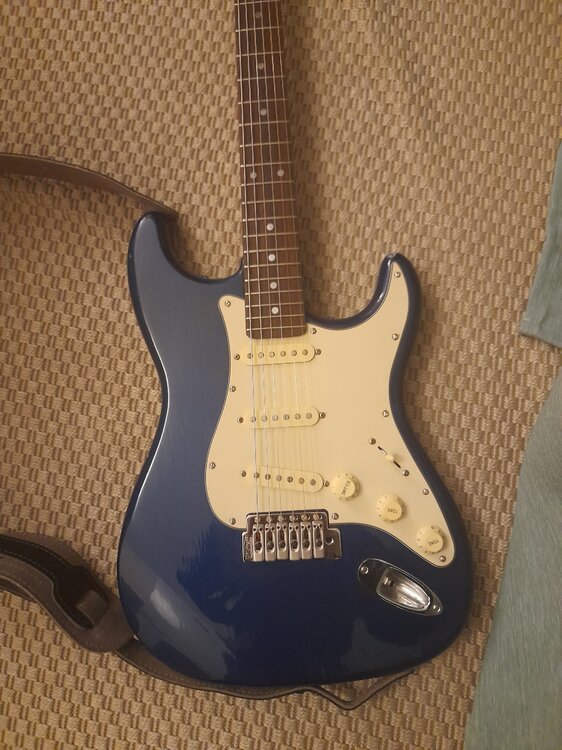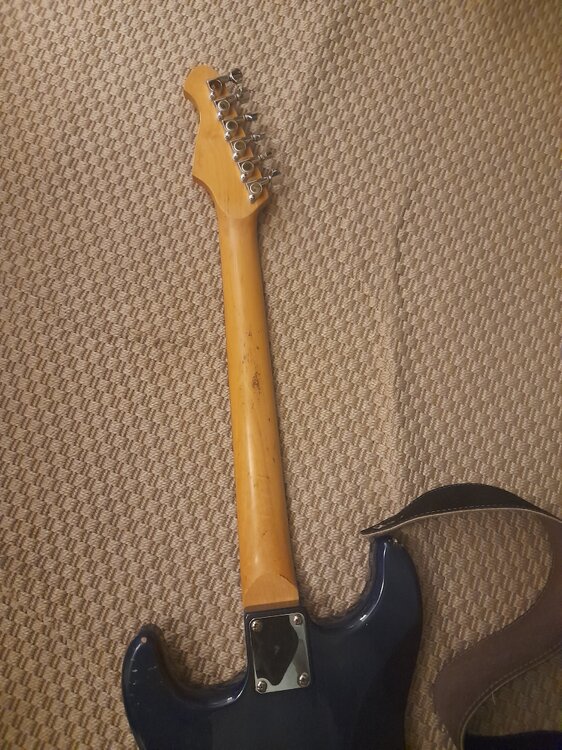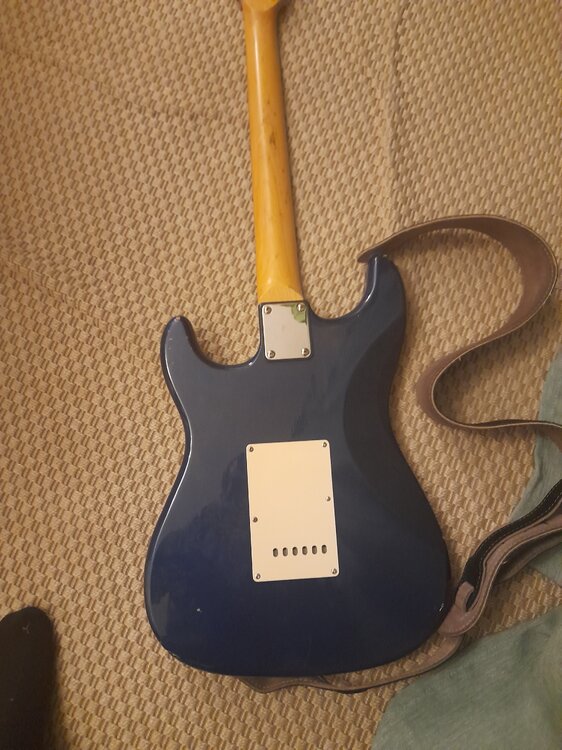Leaderboard
Popular Content
Showing content with the highest reputation on 21/12/23 in all areas
-
Short snappy update as I come to the end of a consolidation phase... bigger & newer things to come in the next week or so.2 points
-
Hi everyone, nice to meet you. I am a "basschatter" but now I hsppen to have two guitars and I am curious about this one. I bought this off ebay. Almost by accident, I made a £35 bid when the auction started just to dip my toe in, then decided to buy new Fazley telecaster, and to my surprise I won the auction for the Aria as well. From what I can see from the photos, it is very similar to the STG003 now on sale for about £130. But the bridge is different, and the Aria logo is different. This is not a "pro II". I cannot find a serial anywhere nor a "made in.." The guitar is old, the neck wood looks aged. The pickguard has darkened a lot - it is bright white underneath the knobs. The neck is glossy. The frets are small. I am new to guitar but they are smaller than in my Fazley, which I doubt jas jumbo. The fretwork seems great to me. I can set action lower than in Fender's setup guides with no buzz. Nut slots are cut very well. As you can see it has issues (the black marks on the back of the neck cannot be wiped away). I doubt this is the purchase of the century but I wonder if this may be from a time when Aria STGs cost slightly more than £130.2 points
-
My vintage orientated Aria 615 TL (essentially a 69 thinline tele clone) has small skinny frets too (which I actually like) and a flatter radius (which i don't like so much) so you are probably right. The target market was possibly more vintage minded so makes sense. Although I don't really think that either of my old STG necks are that skinny, more medium so it may well have had a fret dress by the previous owner. But well done to @Paolo85 for trying to resurrect it, I hate to see guitars neglected. Treat her well and she should provide more years of use.2 points
-
They did use better hardware on other models. My Magna series Mac 60 has got the Duncan Designed pickups and Wilkinson hardware and is very nice indeed, but the STG range of this era was very much the beginner series, but excellent versions none the less, if a little bit vanilla and bland. They have done more recent upgrades to the STG series which are supposedly nicer and based on 57 and 62 era strat, but they are designated Pro II (and double the money too compared to the regular base model) but I haven't had the pleasure of trying these as yet. I am a big fan of Aria overall, I have probably had a dozen models from the japanese era through Korean manufacture up to modern Chinese ones and yet to have a real duffer. Most of my basses are Aria (a TSB 350 from 1980, a violin bass from 1969, 1990s Magna bass and P Bass STB from early 2000s - only one pesky Westone bass to muddy the water) and some of my favoured guitars (including my homebuilds) are either Aria or homebuilds using Aria parts (again, only a couple of Vintages and a Tanglewood acoustic to spoil the view on my guitar stands).2 points
-
Morning and welcome. I have a few Aria's, they are great value. This is a slightly older model but definitely made in China. They reinstated the 'Pro II' moniker about 5 years ago so this is before that. I would suspect from the early 2000's so probably about 20 years old. They are good strat copies, nothing amazing, but nothing bad either. Perfectly decent but would benefit from electronics changing as that is their weak point. The bridge looks like a drop in replacement at some point (a Wilkinson?), they would have been a vintage style bridge with the bent saddles. I really like the necks on these and used the neck off my one on a partscaster home build and then bought another neck off eBay (for as much as it would have been to buy the guitar whole) to do another home build... In fact, my main precision bass is an Aria from this period, and I have a Magna series hot rod HSS strat similar age and I really like both. I also have one of the newer (Pro II) thinline telecasters, but I don't think the feel is as good as the older ones, it needs a bit more playing in.2 points
-
Could be. If this one was intended to be a more 'vintage' spec, they might have installed narrow / tall frets like Fender did way back when. Medium-Jumbo and Jumbo frets seem to have started becoming much more of a norm on everything into the 90s?1 point
-
Oh yes! How did I not spot the Wilkinson logo! @EdwardMarlowe I think you are right somebody loved this guitar. Before they sold to somebody who just dumped it in a filthy corner (it was in a terrible state when I bought it). Nut slots could have easily been cut to a good height by the owner who installed the new bridge. I suppose there may be a small chsnce that dmall frets and good fretwork overall have to do with a fret dressing. Unlikely though st this price point. I once had a cheap Squier P bass made in China from early 2000s and it had small frets. Maybe it was the fashion back then? I'll have a look under the pickguard at the first string change (not very soon I hope/guess as I have put some Thomastick flatwounds on!1 point
-
I think it matters more for some types of sound. There's a Rick Beato vid on Youtube where he shows how, contrary to the popular opinion that "heavy equals teh tonez", if you're a shredder playing with a lot of gain and distortion, lighter strings actually give you a clearer tone. Maybe that's why Brian May plays, if memory serves, eights (how he doesn't snap strings all the time mystifies me, especially given what he uses for picks...). I started out with 9s. The first thing I did with my first electric was restring it (it was right handed, I'm a southpaw and Hendrixed it - left-handed guitars were a whole lot rarer, especially used, in 1991). I kept snapping the high e, so after a bit I started buying a separate 10 and putting that on for the high E. Meant it was a lot close what I was using for a B from a 9 set, and felt a little different, though no derogatory effect on the sound. Eventually I just switched up to tens all over, and have been happy with that since. Over time my pick of choice also went up from a .46 to, nowadays, anything from 1mm to 2mm, which works fine with 10s - guess I've figures out the right 'grip' as to not snap 'em all the time now.1 point
-
Indeed. I'd be looking at a quality steel (or brass?) trem block replacement if it's the cheaper zinc type in there. Otherwise, don't see any need to replace the whole thing, unless you luck into a deal where the whole unit with a quality block is cheaper than the block alone.1 point
-
Yeah, I spotted that bridge too. I did wonder whether Aria had done a series where they used better hardware, but you are probably right it's a later replacement. Which suggests a previous owner enjoyed this guitar well enough to take the time, effort and expense of that modification. There may be others - I would expect they at least did a good set-up on it, but I wonder too if any of the other big plus points you've noticed were down to the same owner's investment? Be interesting to have a look under the guard to see if there are any signs of anything being changed there.1 point
-
I have always been happy with the Wilkinson hardware for my home build strats (although I always use a blocked trem), and they make several sizes to fit what you already have without modifications if needed. But, as @ezbass asks, why would you need to swap it out? I haven't had any problems with the trem in any of the Fender or Squier strats that I have had (and that is about 60 to my shame....). If it is just to replace the bloack, then loads of aftermarket options will fit.1 point
-
Wise words... It was a challenge moving down to 8s from the 10s that I had played for years and did require significant control and concentration on clean technique for a couple of weeks, but now I don't notice any difference except the ability to play for longer periods. But as said... standard 10-46 strings are standard for a reason, they suit most styles and most players and any reason for change is purely a personal choice.1 point
-
In my now-very-distant youth, I foolishly swapped my splendid Hofner President for a Burns Bison (yes, I know; idiot move I've regretted for decades...). The daft idea I had at the time was to dabble in Lead Guitar Playing. To this end, I knew that bending notes was The Name Of The Game, so what better than to have bendable strings, eh..? I cobbled up a set with a high 'E' '7'; the rest went from there (probably taking a set of 10-46 and moving 'em all over by one...). Yes, of course, it was unplayable, partly because I was, and have remained, a pitiful Lead Guitarist, but mostly because these strings were not strings, but cobwebs..! The slightest touch produced notes hitherto unknown to musicology, worthy of the best synth oscillators, wobbling about between [note played] and [note played plus several random half-tones]. It is not to be wondered at, why I chose to switch to drums. The Burns was traded in for a keyboard for my girlfriend at the time, which in turn became a Hohner Pianet for my parents (my father wanted to learn the piano...). The moral of this sad tale..? Use 'standard' strings unless there is a very, very good reason dictated by experience and wisdom; there's a reason why most folk do so. a set of 10-46 suit most folk playing most electric guitars, end of. OK, OK... I'll make an exception for those playing heavy metal riffs, that may evolve to 'top light-heavy bottom' sets, to go 'chunkachunkachunka' with for hours, but that's all. I'm off now to do a bit of drumming...1 point
-
Thanks both. Given my appaling track record of bodging things or just not completing, probably picking up a 2nd hand PRS would be the obvious option. But now I know!1 point
-
There's no right way or wrong way, whatever way suits you is what's best. I hold picks differently when I play electric to when I play acoustic.1 point
-
Remember, Eddie Van Halen held his pick between his thumb and middle finger, so that he could used his index finger for tapping. Whatever works for your style is the right way, don’t be afraid to experiment.1 point
-
I tend to hold mine like you do in the op picture, but there's nothing inherently wrong with holding a pick anyway that is comfortable, secure and makes a pleasing sound. When playing electric guitar, I tend to hold my pick 'upside down', using the blunt end to hit the strings, but for acoustic, I hold it the conventional way around (both ways are for tonal reasons). One of the reasons I hold my pick like your first photo is that I like to use pick and fingers, also known as hybrid picking.1 point
-
I'd recommend a 'trigger'-style capo, for its consistent efficiency, ease of use and solidity. Here's four, from Amazon; cheap enough to try out, with a slightly more expensive option... Amazon Trigger Capos ... Our Eldest uses these (or ones like 'em...), fitting one for the intro of 'Under The Bridge' before whipping it off for the rest of the song. Our Second Guitar uses one, too, to match the singer's choice of key. They all have rubber 'jaws', and do no harm at all to the guitar neck. Hope this helps. Edit : Note the difference in shape between a 'flat' one (for nylon, classical, flamenco guitars with flat fingerboard...) and 'curved' (for electric, archtop, radiused fingerboards...) and buy accordingly. The rubber jaw will accommodate any slight difference in curveture, normally.1 point

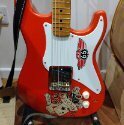
.thumb.jpg.2f0f241a63381e5644f287abacd76760.jpg)

.thumb.png.5ee2f5dc8ab253d965d437b6a37cbc2e.png)
